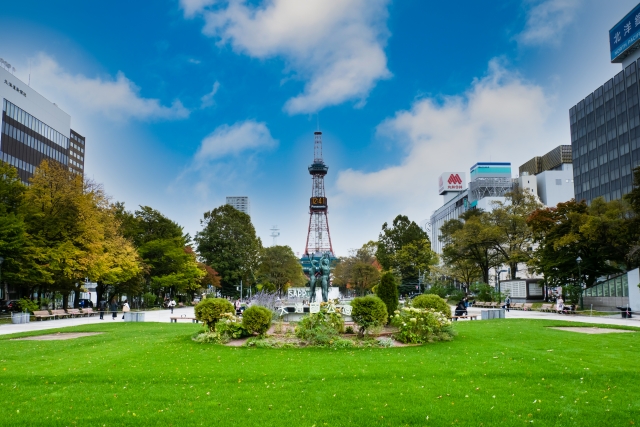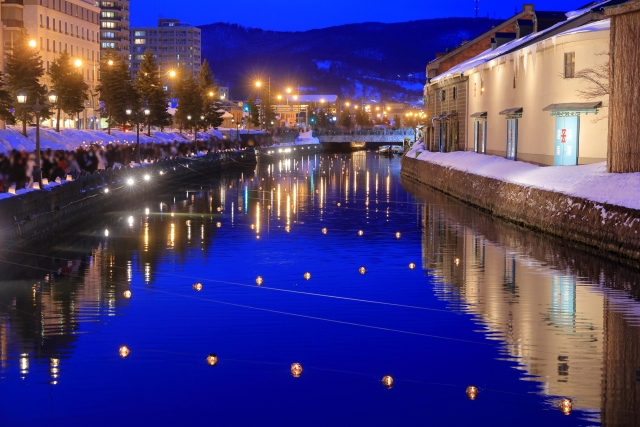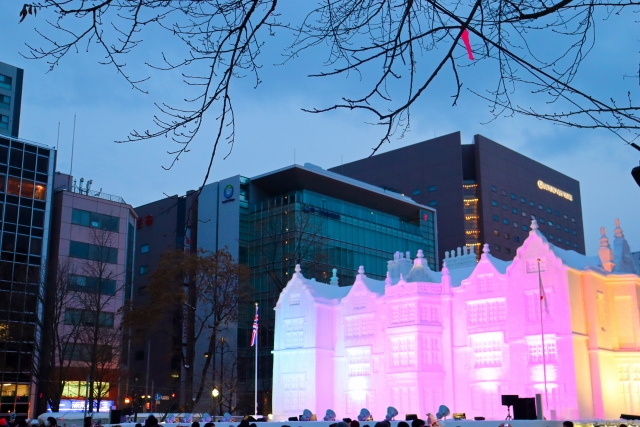Japan’s snow festivals transform the country’s winter landscape into magical wonderlands of ice and snow, attracting millions of visitors annually.
From the world-famous Sapporo Snow Festival to smaller local celebrations, Japan offers unforgettable winter experiences that highlight Japanese artistry, culture, and resilience during the coldest months.
Sapporo Snow Festival
The Sapporo Snow Festival (札幌雪まつり) stands as Japan’s premier winter celebration and one of the most famous snow festivals globally.
This spectacular event transforms Hokkaido’s capital city into an extraordinary outdoor museum of snow and ice art, drawing over 2 million visitors annually.
The festival began modestly in 1950 when local high school students created six snow statues in Odori Park.
Today, it has evolved into an international event featuring hundreds of breathtaking snow and ice sculptures, some reaching heights of 15 meters or more.

Dates and location

The Sapporo Snow Festival typically runs for seven days in early February.
The festival spans three primary sites across the city:
- Odori Park (大通公園) – The main venue stretching across 1.5km through central Sapporo, featuring the largest sculptures
- Susukino Site (すすきの会場) – Located in Sapporo’s entertainment district, showcasing beautiful ice sculptures
- Tsu Dome Site (つどーむ会場) – A family-friendly area offering snow slides and interactive activities
However, always check the official website for the most current information, as dates can slightly vary year to year.
Sculpture highlights
The snow sculptures at the Sapporo Snow Festival range from intricate replicas of famous buildings to beloved characters from popular culture.
Each year features different themes and designs, ensuring a unique experience even for repeat visitors.
Notable sculpture categories include:
| Category | Description |
|---|---|
| International Competition Pieces | Created by teams from different countries, showcasing diverse artistic styles |
| Architectural Reproductions | Detailed replicas of famous global landmarks and Japanese historical buildings |
| Character Sculptures | Representations of anime, video game, and movie characters |
| Japanese Cultural Motifs | Traditional Japanese symbols, mythology, and historical figures |
The sculptures are particularly spectacular at night when they’re illuminated with colorful lights, creating a magical atmosphere throughout the festival grounds.
Transportation tips
Reaching the Sapporo Snow Festival is straightforward.
Getting to Sapporo:
- By Air – New Chitose Airport (CTS) serves as the main gateway to Hokkaido, with numerous domestic flights from Tokyo (90 minutes) and international connections. From the airport, the JR rapid train reaches Sapporo Station in about 40 minutes.
- By Train – The Hokkaido Shinkansen connects Tokyo to Shin-Hakodate-Hokuto (4 hours), followed by a limited express train to Sapporo (3.5 hours).
- By Ferry – Overnight ferries operate from Niigata, Maizuru, Tsuruga, and Kyoto to various Hokkaido ports, offering a unique travel experience.
Getting around festival sites:
Once in Sapporo, the festival locations are easily accessible:
- Odori Park – Directly accessible from Odori Subway Station (multiple lines) or a 10-minute walk from Sapporo Station
- Susukino Site – Adjacent to Susukino Subway Station, one stop south of Odori
- Tsu Dome Site – Shuttle buses run from Sapporo Station during the festival, or take the Toho Subway Line to Sakaemachi Station and walk 15 minutes
Consider purchasing a one-day subway pass (¥830 for adults) for unlimited travel on festival days.
Accommodation
Securing accommodation during the Sapporo Snow Festival requires advance planning, as hotels book up months ahead.
For the best rates and availability, booking 3-6 months in advance is highly recommended.
Many visitors also consider staying in nearby cities like Otaru (30-40 minutes by train) where accommodation may be more readily available.
Other Major Snow Festivals
While the Sapporo Snow Festival may be Japan’s most famous winter celebration, numerous other spectacular snow and ice festivals take place throughout the country.
These regional festivals each offer unique attractions and experiences, often with fewer crowds and more intimate atmospheres than their Sapporo counterpart.
Otaru

The Otaru Snow Light Path Festival (小樽雪あかりの路) offers a more intimate and romantic winter experience compared to Sapporo’s grand displays.
Held concurrently with the Sapporo Snow Festival (typically early to mid-February), this charming celebration transforms the historic canal city of Otaru into a winter wonderland illuminated by thousands of snow lanterns.
Unlike other snow festivals focusing on large sculptures, Otaru’s festival creates magic through small, handcrafted snow candle holders (雪あかり) that line the famous canal, historical streets, and hillside paths.
The reflection of candlelight on snow creates an unforgettable atmospheric glow each evening.
Otaru is easily accessible from Sapporo via a 30-minute train ride on the JR Hakodate Line, making it the perfect companion visit to the Sapporo Snow Festival.
Asahikawa
The Asahikawa Winter Festival (旭川冬まつり) stands as Hokkaido’s second-largest winter event, typically held in early February at Asahikawa City’s Asahibashi Site and Heiwa Dori Shopping Street.
The festival’s centerpiece is usually a massive snow sculpture—often exceeding 30 meters in width and 20 meters in height—making it among the largest snow structures in Japan.
Asahikawa is accessible from Sapporo via limited express train (approximately 1.5 hours) or highway bus (2 hours), making it possible to visit as a day trip or as part of a wider Hokkaido winter itinerary.
Lake Shikotsu
The Lake Shikotsu Ice Festival (支笏湖氷濤まつり) offers one of Japan’s most unique winter spectacles.
Unlike other festivals that work primarily with snow, this celebration creates otherworldly ice formations through a distinctive process: water from the lake is continuously sprayed onto surrounding structures, freezing layer by layer into translucent ice sculptures that grow organically throughout the winter.
Located at Hokkaido’s Lake Shikotsu, Japan’s northernmost ice-free lake, the festival typically runs from late January through mid-February.
Lake Shikotsu is approximately 60 minutes by bus from Chitose or Sapporo, with increased services during the festival period.
Nagano
Nagano Prefecture, host of the 1998 Winter Olympics, offers several noteworthy snow festivals that showcase central Japan’s winter beauty and traditions.
The Nozawa Onsen Dosojin Fire Festival (野沢温泉道祖神祭り), held annually on January 15th, combines snow celebrations with one of Japan’s most spectacular fire festivals.
Niigata
Niigata Prefecture, receiving some of Japan’s heaviest snowfall, hosts several distinctive winter festivals that showcase rural Japan’s relationship with snow.
The Tsunan Snow Festival features Japan’s largest snow kamakura (snow hut) alongside a spectacular fireworks display over the snow-covered landscape. The combination of fireworks reflected on snow creates mesmerizing views not seen in summer fireworks events.
Meanwhile, the Iwamuro Onsen Snow Festival celebrates with unique “yukiakari” (snow lanterns) throughout this historic hot spring town.
Local artisans create delicate snow and ice sculptures illuminated from within, creating a magical evening atmosphere for visitors exploring the town’s narrow lanes.
Perhaps most unique is the Koide Himatsuri (Koide Fire Festival), where massive torches up to 10 meters tall are carried through snow-covered streets before being burned in a ritualistic ceremony believed to drive away evil spirits and ensure good harvests.
Many Niigata snow festivals are accessible via the Joetsu Shinkansen from Tokyo to major stations like Niigata or Echigo-Yuzawa, though some remote festivals may require additional local transportation.
Toyama
Toyama Prefecture, located along the Sea of Japan coast, offers unique winter festivals that combine heavy snowfall with local traditions and stunning natural settings.
The Inami Camphor Tree Light-Up transforms the region’s ancient trees into magical snow-covered art pieces. The UNESCO World Heritage village of Gokayama uses its traditional gassho-zukuri farmhouses as dramatic backgrounds for snow lanterns during their winter light-up events.
Most impressive is the Tateyama Snow Corridor Festival, celebrating the famous “Snow Walls” of the Tateyama Kurobe Alpine Route. When the route opens in mid-April, visitors can walk between snow walls reaching up to 20 meters high—the result of tremendous snowfall and months of careful clearing work.
Planning Snow Festival Journey
Creating the perfect snow festival itinerary requires careful planning to maximize your experience while minimizing challenges associated with winter travel in Japan.
Best time to visit
The optimal period for experiencing Japan’s snow festivals falls between late January and mid-February, when most major celebrations coincide.
Here’s a general timeline of major snow festivals to help with planning:
| Festival | Typical Dates | Peak Days |
|---|---|---|
| Sapporo Snow Festival | Early February (7 days) | First weekend |
| Otaru Snow Light Path | Early February (10 days) | Concurrent with Sapporo |
| Asahikawa Winter Festival | Early-mid February (5 days) | First weekend |
| Lake Shikotsu Ice Festival | Late January to mid-February | Early February weekends |
| Tokamachi Snow Festival | Mid-February (3 days) | Saturday |
| Yokote Kamakura Festival | February 15-16 (fixed dates) | Both days equally important |
For the best experience, consider these timing factors:
- Weekdays vs. weekends – Weekdays offer smaller crowds but potentially reduced programming, while weekends feature maximum activities but larger crowds
- Festival progression – Early days show pristine sculptures, while later days may show weather effects but often feature special closing ceremonies
- Illumination hours – Most festivals offer special illumination from sunset (around 5:00 PM) until 9:00-10:00 PM
A well-planned two-week itinerary in early February can potentially include the Sapporo Snow Festival, Otaru Snow Light Path, and several other regional celebrations, making for a comprehensive snow festival experience.
Weather considerations
Winter in Japan’s snow regions brings challenging conditions that require proper preparation.
Average conditions during festival season (late January-mid February):
| Region | Daytime Temp | Nighttime Temp | Snowfall Probability |
|---|---|---|---|
| Sapporo/Hokkaido | -1°C to -4°C | -8°C to -12°C | 70-80% |
| Niigata/Nagano | 1°C to 3°C | -5°C to -7°C | 60-70% |
| Toyama/Japan Alps | 3°C to 5°C | -3°C to -5°C | 50-60% |
Remember that festival viewing involves significant outdoor time, often standing relatively still.
Most festivals have warming stations or indoor areas where you can temporarily escape extreme cold.
In Sapporo particularly, the underground shopping arcades provide convenient warm passageways between festival areas.
Cultural etiquette
Important etiquette considerations include:
- Remove shoes when entering traditional buildings, ryokan accommodations, and some restaurants
- Observe queuing etiquette – Japanese queues are organized and orderly, even in crowded festival environments
- Dispose of trash properly – Most festivals have designated waste stations with separate recycling categories
- Indoor voice – Even in crowded festival areas, Japanese visitors tend to speak quietly
Learn basic Japanese phrases before your trip. Even simple greetings and expressions of gratitude are appreciated by locals and enhance your cultural connection during festival experiences.


comment